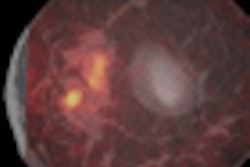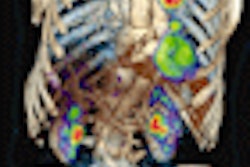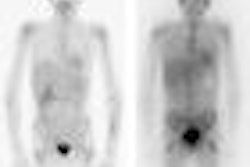Sonography is cheaper, more reproducible, and faster than scintigraphy for evaluating gallbladder function using sincalide cholecystokinin (CCK), according to research published in the September issue of the Journal of Ultrasound in Medicine.
"Scintigraphy estimated a lower [ejection fraction (EF)] than sonography, had wider EF variability than sonography, and required additional time (> 30 minutes more) to complete the study," wrote a research team led by Dr. Richard Barr of Radiology Consultants in Youngstown, OH.
Both sonography and scintigraphy have been used to evaluate gallbladder function using CCK, but they often report different ejection fractions because they measure slightly different parameters. To directly compare the two methods, the Ohio research team evaluated 20 healthy volunteers using both imaging modalities simultaneously (J Ultrasound Med, September 2009, Vol. 28:9, pp. 1015-1018).
The nine males and 11 females participating in the study ranged in age between 21 and 60, with a mean of 41.6 years. They did not have a history of gallbladder disease or right upper quadrant pain, were not taking any medications, and had normal gallbladder sonographic findings.
All participants of childbearing potential had a negative urine beta-human chorionic gonadotropin test result, and any potential participants found to have gallstones or gallbladder wall thickening (greater than 3 mm) were excluded from the final study group, according to the authors.
After fasting overnight, the volunteers received CCK (Kinevac, Bracco Diagnostics, Princeton, NJ); a standard dose (0.12 µg/kg of body weight) was placed in 50 mL of normal saline and administered intravenously at 100 mL/hour. They were placed on a standard single-head scintigraphy camera, and an ultrasound scanner was placed next to participants to allow for simultaneous evaluation.
A single sonographer performed the sonographic examinations on a Spectra VST ultrasound unit (Diasonics) using a 4-MHz curved-array probe. For scintigraphy, 6-8 mCi of technetium-99m mebrofenin (Choletec, Bracco Diagnostics) was injected intravenously.
After the start of the CCK injection, volume measurements were obtained at approximately five-minute intervals alternating between the two modalities. The researchers then calculated the statistical significance between the different gallbladder ejection fractions recorded by the two techniques.
Sonography produced mean EFs of 66.3% ± 20%, whereas scintigraphy yielded mean EFs of 49% ± 29 (p = 0.19). Mean times to the peak EF were 38 ± 12 minutes for sonography and 33 ± 9 minutes for scintigraphy.
The researchers also noted an average time of 34 minutes after radiopharmaceutical injection before CCK administration was performed for the scintigraphic studies.
"Scintigraphy could not be performed in 5% of the participants because of nonfilling of the gallbladder," the authors wrote.
The earliest time to peak EF for sonography was 15 minutes, and the latest time was 60 minutes (mode, 40 minutes). As for scintigraphy, the earliest and latest times were 15 and 50 minutes (mode, 30 minutes).
Scintigraphy also demonstrated a larger standard deviation of the gallbladder ejection fraction than did sonography.
"CCK gallbladder EF calculations by sonography are less time-consuming, more reproducible, and less costly," the authors wrote. "With these techniques, the range of normal gallbladder EFs should be adjusted for the technique used."
By Erik L. Ridley
AuntMinnie.com staff writer
September 3, 2009
Related Reading
Adding cine clips to ultrasound protocols boosts efficiency, April 8, 2009
Future of ultrasound will require technology, educational gains, April 4, 2009
Ultrasound can boost imaging use in developing countries, November 21, 2008
3D ultrasound can improve life for sonographers, save money, March 18, 2008
Aw shucks! Corn-oil-based scintigraphy makes good in gallbladder disorder, January 20, 2005
Copyright © 2009 AuntMinnie.com



















